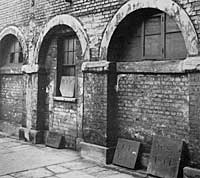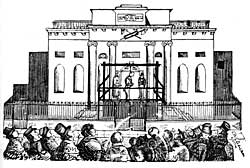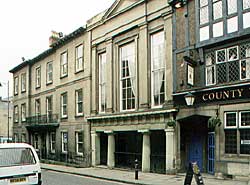< Previous | Contents | Next >
 Yard at Shire Hall with headstones for executed prisoners.
Yard at Shire Hall with headstones for executed prisoners.Lower down than this debtors' prison there still remains an exercise yard closely walled in, and whose walls are covered with scratchings and initials wrought by hundreds of prisoners, and, perhaps the most gruesome of all, there are still preserved the gravestones of executed criminals bearing merely their initials and the date of their death.
To the east of this there is an entry to a dark underground cave which has all the appearance of one of the rock cellars so common in Nottingham, but which may have been used as a mediaeval prison. Adjacent to this, mixed up in a great deal of almost unexplainable substructure, are two terrible cells which were used as free sleeping-quarters for impecunious debtors, but whose later history is as condemned holds. They are six or eight feet long by about four feet wide, and when the great iron-studded doors which close them are shut they are almost pitch dark, what little light and ventilation they get comes through a small hole about six inches diameter and heavily barred above the door.
Below this there are still other prisons hewn out of the rock, but they are extremely difficult and unsafe of access, and their history is exceedingly obscure. There are countless stories of horrors which have occurred in these prisons, of which it is unnecessary to speak, for those who have once seen these dungeons can picture for themselves some of the miseries which they have witnessed. There is, however, one remarkable event which is well worth recording, for in the year 1537 Cicely Ridgeway was confined in Nottingham prison for refusing to plead guilty to the murder of her husband. Such was her determination that she remained for a period of forty days without any sustenance whatever. This was looked upon as a miracle, and she received her discharge.

Hanging at Shire Hall, 1864.
It was outside the Shire Hall that the last public execution in Nottingham took place, and there still remain marks upon the facade which show where the gallows used to be temporarily erected. In olden times execution followed sentence with terrible swiftness. A criminal who was condemned was executed upon the following day, and the more merciful judges were wont to postpone the sentence until Saturday, for as Sunday was a "dies non" in the eyes of the law, a person condemned on Saturday was not executed until Monday, and so had one day longer in which to prepare for his doom. The history of Nottingham gallows is not without interest, although its beginning is very obscure the first mention being in 1496. By 1558 the site of the gallows was permanently fixed upon Gallows Hill, very near the site where the present lodge to the Church Cemetery stands, and to this point a long procession of wretched criminals was led to expiate their offences. However, by 1831 this gallows was abandoned and executions took place in front of the Shire Hall in the full view of the public. The last public execution took place in 1861 and was that of Richard Darker, who paid the penalty for killing his mother at Fiskerton. After that time executions took place privately at the west end of the yard in the prison, which we have just considered.
It is an interesting commentary upon the ancient feeling towards the Jews to remember that there was a special gallows erected in what we call Shakespeare Street for the accommodation of Jewish malefactors, for public opinion would not tolerate the execution of Jews upon the Christian gallows.
Just opposite to the Shire Hall, upon the north side of High Pavement, stands a very fine brick building (No. 29). It is by far the best piece of brick workmanship in Nottingham, and has been said by competent judges to be the best piece of brick building in the whole of England. It was erected in 1820, and each of its facing bricks after being burned was carefully rubbed, trued on sand paper, and thicknessed to a gauge. The mortar was very carefully mixed and possibly passed through a sieve to prevent impurities, so that the whole structure is really a piece of consummate craftsmanship.
It is a curious thing that, although the Romans were adepts at brick-building, the custom of using bricks seems to have died out in England with the departure of the Roman authorities, except in a few isolated districts such as Essex where stone is almost non-existent. Brick-building remained in use on the continent, particularly in the Low Countries, all through the middle ages, and it was gradually re-introduced into England during the 14th century. By the time of Charles I. bricks had become very general, and so much inconvenience was caused by the variety of their size that an Act of Parliament was passed regulating their dimensions. In 1625 it was enacted that their length should be 9 inches, their breadth 4f inches and their thickness 21/4 inches; of course nowadays they are 9 inches by 3 inches by 4 inches.
The usual bond which is used nowadays is called the "Flemish Bond," and consists of a brick laid length ways called a "stretcher," alternating with one laid head ways which is called a "header," but from the XV. century to the end of the 17th century there obtained in England another bond which is called the "English Bond," and which consists of one course of bricks being laid as "headers" and the next as "stretchers." Although this English bond was revived in the 18th century it is a very useful indication of the age of an ancient brick building. In 1850 this magnificent house was in the occupation of Mr. Booth Eddison, who was an eminent surgeon of this time, and it is now descended to use as a warehouse.

Judges' Lodgings, High Pavement (A Nicholson, 2001).
No. 23, which is now used as a branch of the County Offices, is a house with both history and internal beauty. For many years it was used as the Judge's Lodgings, and behind it is a really charming garden which forms an oasis of greenery which it is very difficult to see from anywhere else than the windows of the schoolrooms of Halifax Place Chapel. It is a 17th century house which was greatly altered about 1833, about which time it was purchased from the Fellows family, who had removed thither from a smaller house a little to the west. Before their time it was occupied by Lady Hutchinson, the mother of Colonel Hutchinson. In 1656 this good lady was prosecuted at the Assizes for having music in her house upon the Sabbath Day. We have another striking case of the terrible intolerance of the Puritan times given in "Bailey's Annals of Nottingham." Mr. Marmaduke Moore, Rector of Ordsall, "had been guilty of the damnable offence of playing cards upon three several times in his own house with his wife which would create scandal of religion drawing down the wrath of God upon this land." His estate was forfeited as if for treason, and he was for ever sequestered from his living. This occurred in 1652.
The entrance hall to this house is at present a veritable museum containing strange relics of the past, such as the javelins borne by the old javelin men, ancient carbines and so forth, and leading out of it are beautiful panelled rooms containing more than one secret cupboard, but the most striking relics of all are the battered remnants of two kettle-drums which hang upon the walls. These are the kettle-drums which beat the charge of the Duke of Kingston's Light Horse at the battle of Culloden, when "Bonny Prince Charlie" was defeated in 1746. Who the Duke of Kingston was we have seen when we were considering the residence of the Pierrepont family in Stoney Street, and the representative of this family was one of the principal movers in the raising of the regiment of horse in Nottingham and districts during the terrible times of 1745. They were equipped with skull caps and breast plates and they did exceedingly good service. By 1746 they had become the 15th regiment of Dragoons, or "Elliott's Light Horse," and they earned for themselves a bad name for their treatment of folk with whom they were called upon to deal. Dragoons were so called from the "dragon" or carbine which they carried, and a dragon was really a foot soldier who used a horse for convenience of transport, just as the mounted infantry which were of so much value during the Egyptian campaign at the close of last century.
